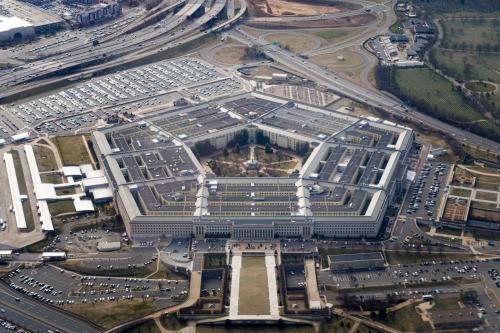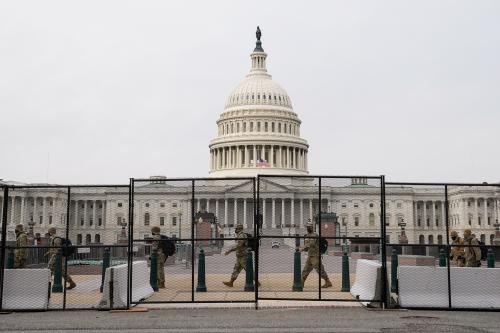As we approached the second anniversary of 9/11, the event now identified simply by numerals, I joined with Marvin Kalb in anchoring a program at the National Press Club in Washington on our new book, The Media and the War on Terrorism (Brookings Institution Press, Washington). Our assignment was to assess what the book calls “the clash of responsibilities”: The government’s responsibility for the common defense, as established in the Constitution; and the responsibility and the right, guaranteed by the same Constitution, of the press to tell the public what the government is doing and where and how the government is doing it. Our group’s conclusion was that, after a rocky start in Afghanistan, the Pentagon’s agreement to embed reporters with the troops in Iraq had given the media the opportunity to produce some of the most stunning wartime coverage ever recorded.
Journalists and Pentagon officials agreed that embedding had greatly expanded the pool of reporters who have an understanding of the military’s culture and operations. This had been sorely lacking since the end of the draft, as fewer and fewer journalists experienced active military service.
There also was some concern that embedding can produce a variation of the Stockholm syndrome: The journalists start to identify with the soldiers and lose their professional detachment. Yet the same thing can happen to reporters covering a police beat or a sports team, and journalists must always guard against the tendency.
But even as the assembled journalists and government officials were patting themselves on their backs, they had no illusions that in the next military engagement the government would be as willing to invite the press to come along with virtually no strings attached. This is a press-government conflict that will have to be fought again and again.
BATTLES ALONG THE WAY
In thinking about how to cover the War on Terrorism, however, it is realistic to think of Afghanistan and Iraq as battles along the way. And perhaps even as the most traditional part of the journey. After all, American newspeople have a two-century history of covering battlefields.
Just as the Cold War determined the geopolitics of the world for 40 years, it is now likely that this war will stretch into the next generation. President Bush has rightly reminded Congress and the nation that the war on terror will be “a lengthy war, a different kind of war, fought on many fronts in many places.” In the run-up to the 2004 election, Democrats will challenge some of his actions but not this assumption.
So if this is another war of massive duration — a war that while it is being fought will look like it is a war without end — then a useful way to think of the media’s role is to go back to the Cold War and try to recall lessons that we might learn from how the press covered the threat of international communism from the end of World War II to the dismantling of the Soviet Union.
American news organizations deserve credit for devoting very substantial resources to a continuing story that often took place in obscure parts of the world and may even at times have bored their consumers. There were measurable increases in the appropriate language proficiency of American foreign correspondents. A 1990 study reported, for instance, that all but six of the 49 men and women in the U.S. press corps in Moscow had received language training before being posted.
Unfortunately, at the same time, foreign dateline stories were too often framed merely as a reflection of the Cold War. The experience of the late CBS correspondent Charles Kuralt was not atypical. When assigned to South America, he recalled, “I learned very quickly to put Fidel into every lead.” Seeing international news through a predetermined lens will exclude much that is important in the world. A lesson of Cold War coverage should be that the world is too multidimensional to be depicted for our generation simply as the War on Terrorism.
With the fall of the Berlin Wall, American news organizations rapidly lost interest in international news. Foreign stories in Newsweek magazine dropped from 463 in 1978 to 281 in 1989. Leo Bogart, writing in Presstime in 1997 (April, p. 60), noted that newspapers had cut space devoted to international affairs on the premise that “they can’t compete with television on the world front.” Yet, at the same time, television was also reducing its world news. Foreign datelines on ABC, for instance, dropped by two-thirds in the dozen years before 9/11.
In many ways, the Cold War was a simpler story for the American press to cover than is the War on Terrorism. It is easier to gather information about nation states, even of the authoritarian persuasion, than about freelance terrorist groups. With the exception of Israel, where U.S. news organizations have always maintained a sizable press corps, the War on Terrorism does not play to our media’s strength. The epicenter of the Cold War struggle was in Europe, the part of the world whose cultures American journalists are more apt to understand.
By contrast, more than 25 years ago, the Aga Khan, speaking to a conference of journalists meeting in Nairobi, said, “As a Muslim, one of 700 million, I live in daily astonishment about the incomprehension of Islam and its peoples. Some Western media have perpetuated misconceptions which stick like shrouds to the bones of historical skeletons.” For my book, International News and Foreign Correspondents (Brookings Institution Press), I surveyed 774 foreign correspondents working for U.S. news organizations and only 10 could conduct an interview in Arabic. Nor was comparative religions a subject that American journalists were likely to have studied in college.
UNDERSTANDING ETHNICITY
Another subject so important to understanding the War on Terrorism is ethnicity. Just look at the composition of the Interim Governing Council that the U.S.-led coalition put together in Baghdad. Yet the role that ethnicity plays in international politics has always been difficult for Americans to comprehend and tends to be underestimated by us. This is partly because of our societal emphasis on individual rights rather than group rights, and partly because of the tenacity to which we cling to the myth of America as the melting pot. Alas, the one American political figure who could have helped us sort this out was Daniel Patrick Moynihan, no longer with us, but who leaves behind his magisterial study, Pandaemonium: Ethnicity in International Politics (Oxford University Press, Oxford, England).
To adequately cover this “war without end” will take some repositioning of resources, including training, or finding journalists with different skills and backgrounds, and the clear recognition of what is different about the story. For most newspapers, this will cost little or no extra money. Most newspapers are members of The Associated Press and many additionally subscribe to one or more of the supplemental news services run by The New York Times, the Los Angeles Times and The Washington Post, and Tribune Co. and Knight Ridder. They, as in the past, will do the heavy lifting. What is necessary for smaller newspapers then is the commitment and patience to stay the course, an understanding of what’s important as foreign copy flows into their newsrooms, and the effort to build a constituency for news that may, at times, seem tedious.



Commentary
Covering a “”War Without End””
November 1, 2003